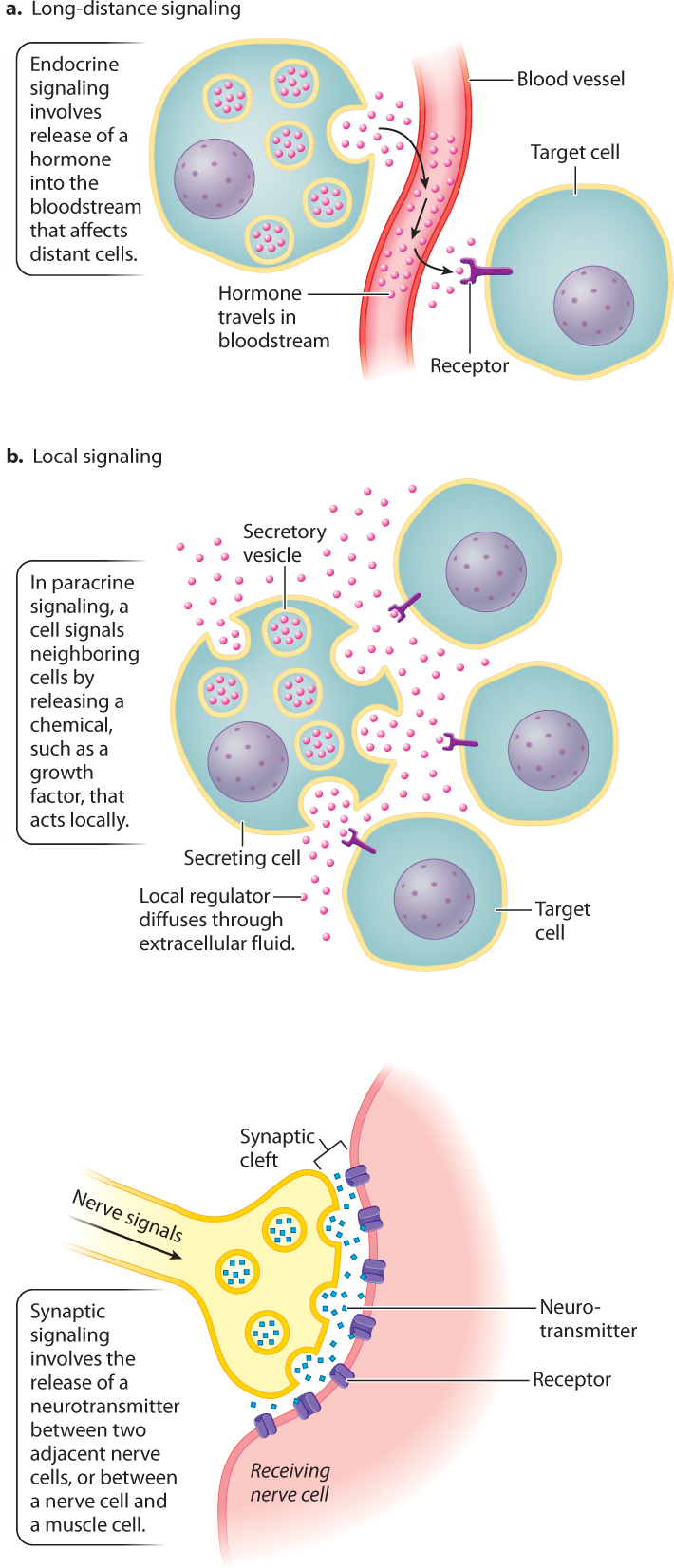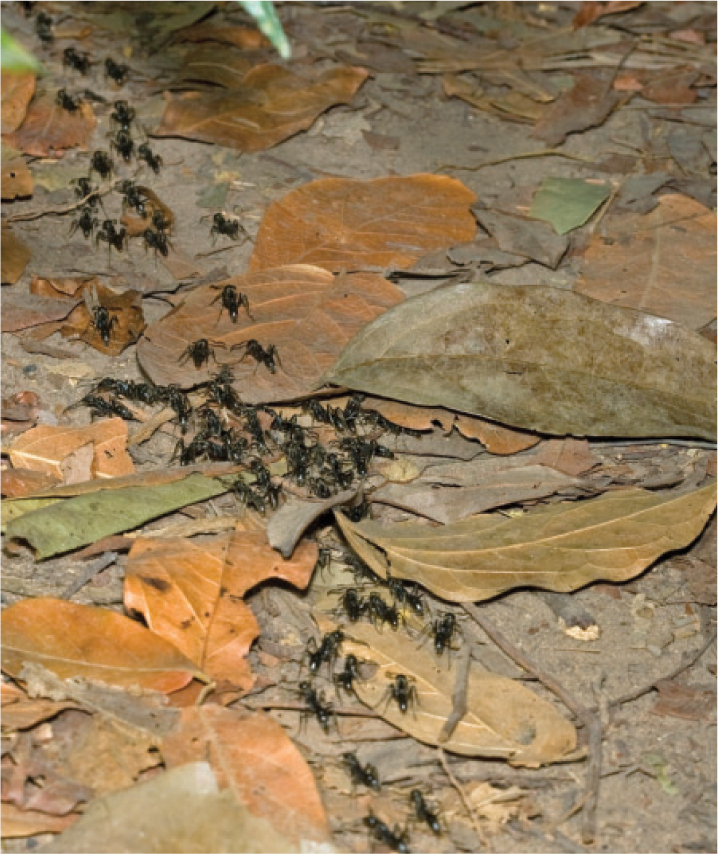38.4 OTHER FORMS OF CHEMICAL COMMUNICATION
As we have seen, hormones are chemical compounds secreted by glands that enter the circulation and act on distant cells, whose response is determined by the presence of receptors that bind the hormones. However, other chemical compounds act over short distances, and still others are released into the environment to signal other individuals of the same species. Here, we explore additional modes of chemical communication and the compounds that produce them.
38.4.1 Local chemical signals regulate neighboring target cells.
Whereas hormones enter the bloodstream to be transmitted to more distant target cells (Fig. 38.13a), other chemical compounds act locally on neighboring cells (Fig. 38.13b). In order to take up the chemical signal, these cells must have receptors for the compound to bind to before the signal degrades or diffuses into the bloodstream.

Chemical compounds that act locally are said to have paracrine function (Fig. 38.13b). If the compounds act on the secreting cell itself, they are described as having autocrine function. That is, the chemical signals may stimulate or inhibit their own secretion. Growth factors (also referred to as cytokines and distinct from the growth hormone released by the anterior pituitary gland) and histamine are examples of paracrine chemical agents released in small amounts that act locally on neighboring cells.
Growth factors (Chapter 9) enhance the differentiation and growth of particular kinds of tissue. For example, bone morphogenetic proteins (BMPs) promote the formation of bone in skeletal growth, and fibroblast growth factors (FGFs) stimulate the formation of connective tissue. Similarly, nerve growth factors (NGFs) promote the survival and growth of nerve cells. When local tissues are damaged, specialized cells release histamine, which dilates blood vessels, allowing blood proteins and white blood cells to move into the region to fight infection and induce repair (Chapter 43). The release of histamine causes the swelling, redness, and warmth that commonly surround a wound. Locally acting signals have immediate, short-term effects because they are quickly degraded.
Another form of local chemical signaling is the synaptic release of neurotransmitters that occurs between directly communicating nerve cells or between nerve cells and muscles at neuromuscular junctions (Fig. 38.13b). Synaptic signaling is extremely rapid and brief compared to the other modes of chemical communication.
38.4.2 Pheromones are chemical compounds released into the environment to signal behavioral cues to other species members.
Animal endocrine systems generally transmit chemical signals that integrate the physiological functions of organ systems within the body. However, many animals release small chemical compounds into the environment to signal and influence the behavior of other members of their species. These water or airborne compounds are called pheromones. For example, female bees and wasps release pheromones to attract male mates. Even plants, such as orchids, release pheromones. Some plant pheromones can attract pollinating bees or wasps by mimicking the chemical signals released by the females of these species. There are many different pheromones, which serve very different functions, as shown in Fig. 38.14.

Female silk moths use pheromones for long-distance communication to attract males. The sex pheromone bombykol, released from a gland in the female’s abdomen, signals her location to males looking for a mate. Sex pheromones play a key role in the mating behavior of many invertebrate and vertebrate species. In most mammals, amphibians, and reptiles, pheromones are detected by a vomeronasal organ with chemosensory neurons in the nasal region of the skull. The release of sex pheromones is one of the most common types of pheromone signaling to attract a mate and trigger ritualistic social and mating behaviors (Chapter 45). Most studies indicate that humans and nonhuman primates lack a vomeronasal organ and do not produce pheromones.
Other pheromones signal territorial boundaries or predatory threats. Dogs and other canids (this family also includes wolves and coyotes), as well as cats, secrete pheromones in their urine that mark their territories. Social seabirds, such as cormorants and boobies, mark their nesting sites by pheromones.
Ants and other social insects commonly deploy alarm pheromones to warn of an attack by an advancing army from another colony. The release of alarm pheromones from a stinging bee causes other bees to swarm and join the attack to defend their nest. In many other species, an animal under attack releases an alarm pheromone, warning its neighbors. Similarly, social mammals such as deer warn of an approaching predator by means of alarm pheromones.

Social insects, such as ants, also deploy trail pheromones that provide chemical cues that other worker ants can follow to a food source (Fig. 38.15). An ant returning to the colony from a food source releases trail pheromones from its abdomen onto the soil. Other worker ants use their antennae to detect and track the concentration of the trail pheromone guiding them along the trail. If you have watched ants marching in line across a sidewalk, a trail, or into and out of your house, you have seen worker ants using pheromone cues to signpost the way to food.
Aquatic species also depend on pheromone signaling. Fish, salamanders, and tadpoles release alarm pheromones into the water to warn of a threatening predator. Prey species that share the same habitat may even sense and respond to the release of another species’ alarm pheromone.
Fish also release pheromones to coordinate mating and to regulate social interactions. In dense populations of cichlid fish living in Lake Tanganyika in central Africa, the ratio of brightly colored breeding males (Fig. 38.16) to females is highly regulated. Only about 10% of males are brightly colored and defend their territory to attract and mate with females. This restriction on the number of dominant breeding males is regulated by behavioral and chemical pheromone cues. When a dominant male dies, subordinate males fight for the vacated territory. When a new male assumes dominance, it becomes brightly colored to attract females and defend its newly won territory. The dominant breeding male reinforces its dominance by releasing pheromones in its urine that signal females and subordinate males in its breeding area. The color change is mediated by hormones released from the male fish’s pituitary gland, which act on pigment cells called melanocytes that are located in the epidermis of its scales. Thus, the fish makes use of both endocrine and pheromone signals to change its behavior and the behavior of other members of its species.

Quick Check 4
What distinguishes paracrine and pheromone signals from endocrine signals?